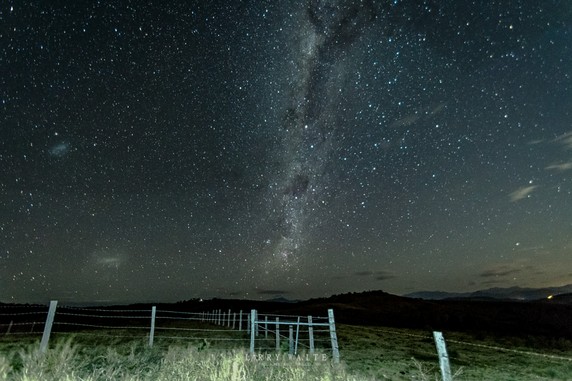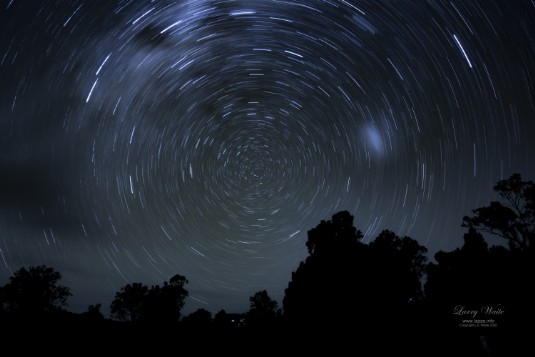Taking the shot
How to
Shoot for the Stars!
Photography is a vast and objective field. I prefer the night sky and trying to capture the stars, particularly the Milky Way, Galactic Core, Nebulas and the odd Moon shot.
I also like to photograph city lights from time to time, but generally I avoid the cities.
Night sky photography and astrophotography is all about capturing light.
The settings you would generally use for day to day photography are usually too small to work in low light.
From ISO 100-500 for day time photography now becomes more like 800- 3200 for night photography.
Shutter speeds are now in seconds and minutes, your aperture usually is at its largest opening size (smallest number).
As mentioned elsewhere on my website, despite some myths, you do not need a full frame camera, a crop sensor works great too! (my pictures are all taken with a Nikon APS-C (1.5x crop sensor)
The longer the camera's shutter is open the more light is gathered. The wider the lens, and the greater the aperture, allows a broader picture and greater light gathering capabilities.
ISO, in simplistic terms, brightens or darkens a photo. But beware, too much ISO creates noise or grain in your picture.
As a basic guide, we actually combine all three for night sky type stuff, whereas during the day your images would be totally blown out with these settings. But at night it is the opposite!
Sit down and take a look at your camera and explore its features.
Don't run out and buy stuff, use what you currently have first to get a basic understanding of what you require.
1. What is the slowest shutter speed 10, 20, 30 seconds? (exposure time)
2. Do you have 'bulb' or 'Time' mode? (this allows your shutter speed to be any length of time)
3. What is the widest angle lens you have? (smallest number ie. 18-55mm with 18 being the widest.
4. Do you have a shutter release? if not look at how to set the timer, say for 10 seconds before it takes the shot.
5. Tripod, or something to rest the camera on. I have used a small bean bag on the bonnet of my vehicle with the camera nestled into it facing up at the sky.

30 Second exposure, ISO 1250, f/2.8 , 14mm, with quick 4 sec flash from a torch to light up the foreground
Go out anywhere you can see stars (including your backyard) and shoot!
The following is a good starting point.
ISO 1250, smallest number 'F' stop you can, (open the iris up to say f/1.8, 2.8 or 3.4 (lens dependent) and a 15-30 second exposure.
Depending on your camera and the lens, how clear the night sky is, light pollution etc., it is expected that you will make a few changes one at a time until you're shooting good pictures. Take lots of pictures, lots of setting adjustments and when you get home examine the pictures on the big screen and see what worked best for you. Make one small change at a time and examine after every shot. Ie: play with ISO until you get a picture with minimum noise, then shutter speed etc.
It's all about balance!
If the shot is too dark, increase exposure time or ISO, too bright do the opposite- One setting at a time! Ie: Increase/decrease ISO take another shot and see what it looks like. Then try increasing/decreasing shutter speed.
Know the 500 rule for the lens you are using for night sky/astro photography (a reasonable guide)
An 18mm lens on a Nikon crop sensor camera is actually 27mm ( 500 divided by 27 = 18.5). So in theory the maximum shutter speed would be about 18 seconds. Anything longer and your stars will look like sausages!
Notes:
* With an 18mm I shoot at 10 or 15 secs max!
* Higher ISO will create noise (some you can live with)
* Longer shutter speeds will create star trails (with your camera in bulb mode, try taking a 30 minute long shot at the stars!)

Checklist A (minimum)
- A camera capable of 15-30 second exposures
- A sturdy tripod
- A cable or remote release (or use your cameras timer)
- A wide angle lens is preferred, I have a few I use including a 14mm Samyang, a 10-24 mm Tamron and the standard kit lens 18-55 mm lens also works quite well.
Checklist B
- All of checklist A
- Spare battery
- Spare SD card
- Variety of lenses ( 10-14mm, 18-55mm and maybe a 200 or 300 to capture the Orion Nebula!)
- Cloth to clean lens (dew can affect the lens on cold nights)
- Stellarium or similar phone app to identify and locate what is in the night sky)
- Photopills App, to help with planning your night shot

